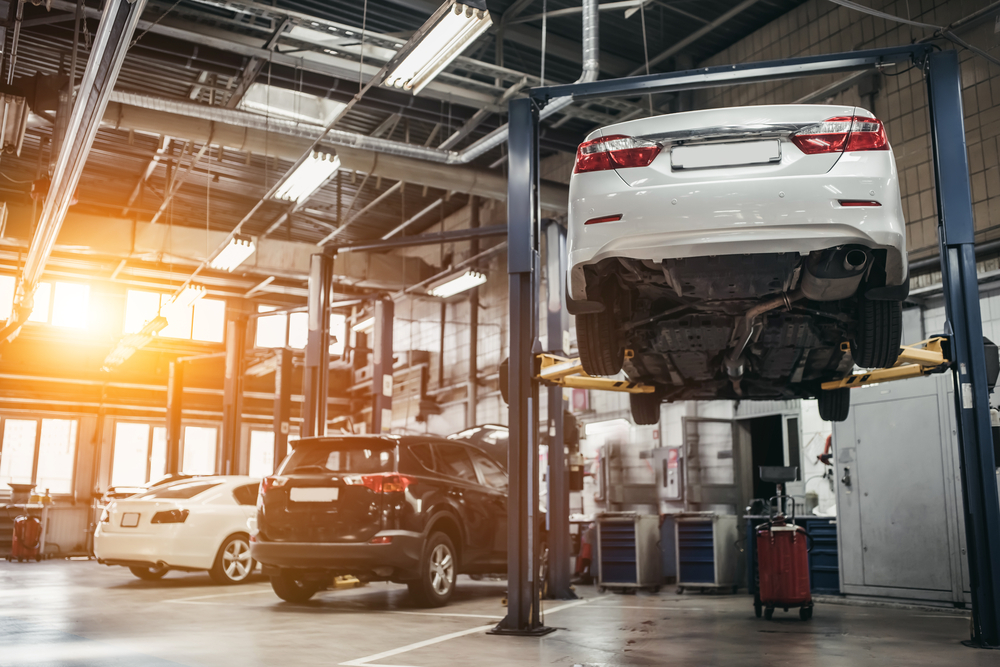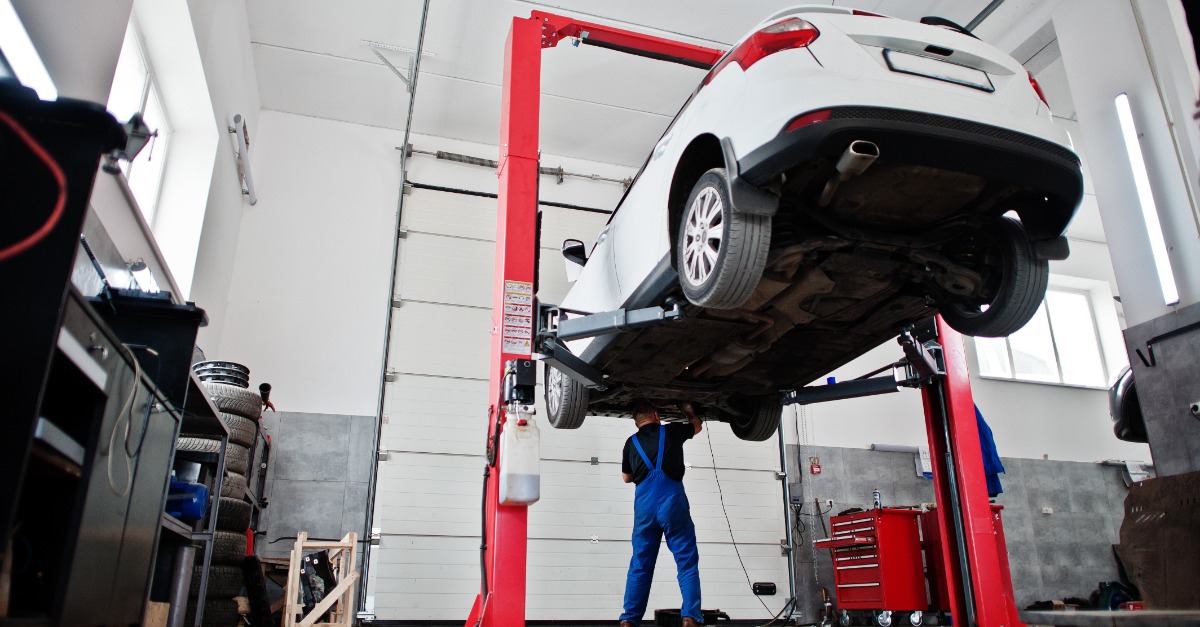What Is Hoisting & Why Do You Need It For Safety Reasons?
Share

“Hoisting” when it comes to automotive maintenance, is the use of lifting equipment or systems designed to elevate a vehicle above the ground. The primary purpose of hoisting is to grant mechanics convenient access to the undercarriage or specific components of the vehicle that require attention or maintenance. This process is essential for vehicle repair, as it facilitates the execution of tasks that involve the inspection, repair, or replacement of parts located beneath the vehicle’s chassis.
Hoisting is important as it enhances the efficiency and safety of various maintenance procedures. By raising the vehicle, mechanics can more easily inspect and work on components such as the exhaust system, suspension, brakes, and other vital parts situated beneath the vehicle. This accessibility is crucial for diagnosing issues, conducting routine inspections, and executing repairs with precision, contributing to the overall reliability and longevity of the vehicle.
Various types of hoisting equipment are used in automotive workshops, ranging from hydraulic lifts and scissor lifts to traditional car jacks. Each type serves a specific purpose and accommodates different vehicle sizes and weights. Hydraulic lifts provide a versatile and efficient solution for elevating vehicles of various sizes, while scissor lifts are often used for quick and straightforward tasks. The selection of hoisting equipment depends on the nature of the maintenance or repair worklift.
In addition to the mechanical advantages it offers, hoisting plays a vital role in ensuring the safety of mechanics and technicians. Elevating the vehicle provides a stable and secure working environment, reducing the risk of accidents and injuries during maintenance activities. Properly hoisting a vehicle also allows for the use of specialised tools and equipment, and increases the precision and effectiveness of the repair process.
Hoisting is fundamental to the execution of various tasks in the automotive industry. It not only provides accessibility to critical components but also enhances the safety and efficiency of the entire repair process. As automotive technology continues to advance, the role of hoisting equipment remains a cornerstone in maintaining and repairing vehicles to optimal standards.
Common types of hoisting equipment used in automotive settings include:
There are a number of different hoisting equipment options available. But the three most common are car hoists, motorcycle hoists, and hydraulic jacks. We discuss it below.
Car Hoists: These are hydraulic or electric lifts designed to elevate entire vehicles, allowing mechanics to access the chassis, suspension, exhaust systems, and other components located underneath.
Motorcycle Hoists: Similar to car hoists but designed specifically for motorcycles, these lifts provide a stable platform for working on bikes, enabling mechanics to perform tasks like oil changes, tire replacements, or other maintenance work.
Hydraulic Jacks: These portable devices are often used for lifting one side or corner of a vehicle, providing a quick and convenient way to access specific areas without the need for a full lift.
Hoisting in the automotive industry is critical for several reasons:
- Efficiency: Hoisting systems in automotive maintenance streamline tasks by granting quick access to various vehicle components. Mechanics benefit from heightened efficiency, leading to a notable reduction in repair time.
- Safety: Proper hoisting equipment ensures stability during maintenance, mitigating the risk of accidents or injuries caused by vehicle falls. It establishes a secure working environment for mechanics.
- Accessibility: Hoisting enables mechanics to reach otherwise challenging components, facilitating thorough inspections and precise repairs. This heightened accessibility is crucial for identifying and addressing issues effectively.
- Versatility: Hoisting equipment is adaptable to different vehicle types and sizes, allowing mechanics to lift a diverse range of vehicles, from compact cars to larger trucks or SUVs.
- Consistent Work Environment: Hoisting systems provide a stable platform for mechanics to perform tasks. This stability contributes to a consistent work environment, enhancing precision in maintenance procedures.
- Compliance with Standards: The use of hoisting equipment aligns with safety standards and regulations in the automotive industry. Adherence to these standards ensures a compliant and secure workplace.
- Reduction of Manual Strain: Hoisting eliminates the need for mechanics to physically lift or crawl under vehicles, reducing the risk of musculoskeletal injuries and strains associated with manual labour.
- Cost-Effectiveness: While initial investment in hoisting equipment is required, the long-term cost-effectiveness is evident through increased efficiency and reduced downtime during maintenance and repairs.
- Optimised Inspections: Hoisting allows for comprehensive undercarriage inspections, facilitating the identification of potential issues before they escalate, thereby preventing more extensive and costly repairs in the future.
- Enhanced Team Collaboration: Hoisting systems create a centralised and accessible workspace, promoting effective collaboration among mechanics working on different aspects of a vehicle simultaneously.
- Preventative Maintenance: The accessibility provided by hoisting equipment encourages regular inspections and preventative maintenance, contributing to the longevity and reliability of vehicles.
When it comes to automotive and mechanical upkeep, hoisting is a significant part of the process. Car hoists, motorbike hoists, and their counterparts serve as indispensable tools that enhance workplace safety and streamline maintenance processes. By providing secure and controlled lifting mechanisms, these systems minimise the risks associated with manual labour and create a stable environment for mechanics to carry out intricate repairs.
What Happens If You Choose Not To Use A Hoist?
Choosing not to use a hoist for vehicle maintenance or repairs can lead to several challenges and potential issues. Here are some of the problems that may arise:
Limited Accessibility: Without a hoist, accessing the undercarriage of a vehicle becomes significantly more challenging. This can hinder mechanics from inspecting, repairing, or replacing components located beneath the vehicle, leading to incomplete or less thorough maintenance.
Safety Concerns: Working underneath a vehicle without proper elevation poses serious safety risks. Mechanics may struggle with confined spaces, increasing the likelihood of accidents, injuries, or even fatalities. A hoist provides a stable and secure platform for technicians to perform tasks safely.
Inefficiency: Performing tasks without a hoist can be time-consuming and inefficient. Mechanics may have to rely on alternative methods, such as using jacks or ramps, which are generally slower and less convenient than a hoist. This inefficiency can result in increased labour costs and longer vehicle downtime.
Limited Precision: Certain maintenance tasks, such as aligning components or conducting detailed inspections, require a high level of precision. Without a hoist, achieving this precision becomes challenging, potentially leading to inaccuracies in repairs and maintenance procedures.
Restricted Repairs: Some repairs or maintenance procedures may be practically impossible without a hoist. Complex tasks, such as working on the exhaust system, suspension, or transmission, often require proper elevation for effective execution. The absence of a hoist can limit the types of repairs a workshop can undertake.
Reduced Productivity: Automotive workshops that lack hoisting equipment may experience decreased productivity due to the limitations on the types of services they can offer. This can impact the competitiveness of the business and customer satisfaction.
Long-Term Vehicle Health: Inadequate maintenance due to the lack of a hoist may result in long-term damage to a vehicle. Neglecting the undercarriage and critical components can lead to issues like rust, corrosion, and accelerated wear, reducing the overall lifespan and reliability of the vehicle.
Not using a hoist in automotive maintenance can compromise safety, efficiency, and the quality of repairs. Investing in proper hoisting equipment is essential for ensuring thorough and precise vehicle maintenance while safeguarding the well-being of technicians.
How Do You Choose A Quality Hoist Provider?
Selecting a reliable hoist provider is crucial for ensuring the safety, efficiency, and effectiveness of your automotive maintenance or repair operations. Here are key factors to consider when choosing a hoist provider:
Reputation and Experience:
- Look for providers with a solid reputation in the industry. Consider how long they have been in business and their track record for delivering quality products and services.
- Check for customer reviews and testimonials to gauge the experiences of other users with the hoist provider.
Certifications and Compliance:
- Ensure that the hoist provider complies with relevant industry standards and regulations. Look for certifications that demonstrate their commitment to quality and safety, such as ISO certifications and adherence to local safety standards.
Product Range and Suitability:
- Assess the provider’s range of hoisting equipment. A good provider should offer a variety of hoists suitable for different vehicle sizes and types of maintenance or repair work.
- Consider your specific requirements and ensure that the hoist provider offers products that align with your workshop’s needs.
Quality and Durability:
- Evaluate the build quality of the hoists offered by the provider. Look for durable materials, robust construction, and features that enhance the longevity of the equipment.
- Check if the hoists are designed to withstand the demands of regular use in an automotive workshop.
Safety Features:
- Prioritise hoists that come equipped with advanced safety features, such as automatic safety locks, emergency stop buttons, and reliable control systems. Safety should be a top consideration in any hoist selection.
Customer Support and Service:
- Assess the level of customer support provided by the hoist provider. Ensure they offer prompt assistance, technical support, and access to spare parts.
- Check if the provider offers installation services and maintenance plans to keep your hoists operating at peak performance.
Warranty and After-Sales Support:
- Inquire about the warranty offered on hoisting equipment. A reputable provider should stand behind the quality of their products with a comprehensive warranty.
- Consider the availability of after-sales support, including maintenance services and readily available replacement parts.
Price and Value for Money:
- Compare prices from different hoist providers, but don’t compromise on quality for the sake of cost savings. Consider the overall value, including product features, warranty, and after-sales support.
References and Case Studies:
- Request references from other businesses or workshops that have used the provider’s hoists. Case studies can provide insights into real-world experiences with the equipment.
Ease of Installation and Use:
- Choose hoists that are user-friendly and easy to install. Complex installation processes can lead to delays and increased installation costs.
By carefully considering these factors, you can select a hoist provider that meets your specific needs and contributes to the success of your automotive workshop. It’s critical to choose a reliable company with a long-standing reputation. Tufflift, brings nearly 30 years of hoisting experience to the table.
Boasting over 60 years of combined expertise in sales, installation, and service, we stand out as an industry leader. Our manufacturing facilities in China adhere to strict Australian standards, ensuring each hoist is Design Registered with Work Safe for the Australian market. We prioritise quality, diverse product offerings, and exceptional customer service to help you select the perfect hoist for your needs. Get in touch today!



